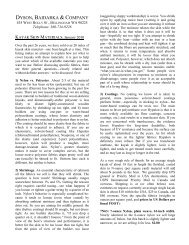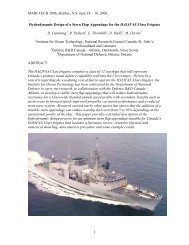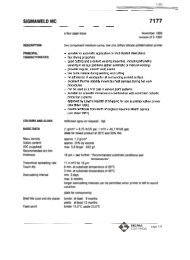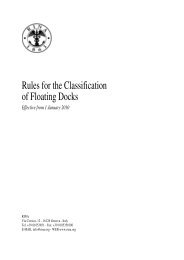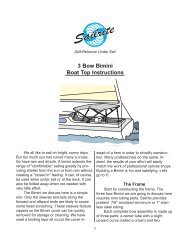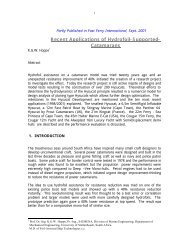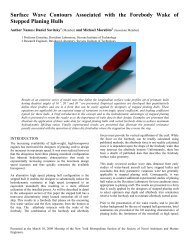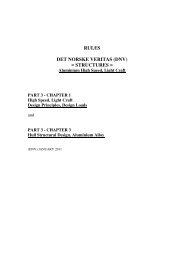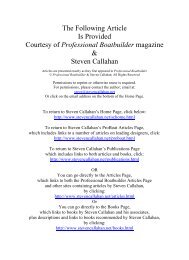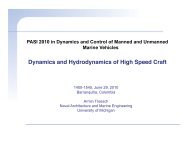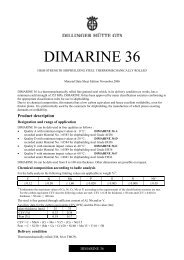Pt B, Ch 12, Sec 22.1.3 Speed of polymerisationThe speed of polymerisation process may be controlled:• either by the amount of accelerators for polyester andvinylester resin systems• or by the amount of a hardener for epoxy resin systems• or by a controlled rise of temperature speed.2.1.4 Resin system referenceThe resin systems may be affected by:• the chemical formulation of polymers used (basic resins,unsaturated monomers, catalysts or hardeners)• the polymerisation process and the additive productsused such as thixotropic or coloured agents.Due to the above, resins are to be used within the limitsfixed by the manufacturer. In this respect, the Surveyor mayask any useful justification to be submitted, such as:• technical data sheet of resin system in a determinedcured condition• manufacturer guarantee for resin used in naval construction(stability regarding ageing in marine environment,resistance to hydrolysis...)• type and proportion of catalyst, hardener and acceleratorrecommended by the manufacturer to be adjusted inthe different circumstances of conditions of work (ambientatmosphere, i.e. temperature, relative humidity, dust)• Type approval certificate for resin system granted by arecognized Society.Note 1: As a general rule, mechanical tests are to be carried out ona panel laminate representative of the hull structure and polymerisationprocess as defined in Ch 12, Sec 5, [4].These mechanical tests aim at examining the final performance ofthe resin system among others.2.2 Resin systems type2.2.1 Polyester systemPolyester resin systems are the result of mixing unsaturatedpolyester resin with an unsaturated monomer, also calledco-polymer, and a catalyst. This reaction is named copolymerisation.• Monomer: the unsaturated monomer, generally styrene,is used to reduce the initial viscosity of the resin beforepolymerisation and to create the chemical links betweenchains of polyester macromolecules. The chemical reactivesites and so the chemical links are located all alongthe macromolecular chains of polyester.This chemical reaction between polyester and styreneleads to the emission of styrene over, not used in thepolymerisation. The global chemical polymerisation isstopped where all the styrene over emission is fullycompleted or where reactive sites of polyester are fullylinked.• Catalyst: generally of organic peroxyde chemical family,catalyst is used to initiate the reaction between polyesterand monomer. It does not take part in the chemicalreaction.The catalyst proportion and its homogeneous mixingwith the polyester/styrene resin before moulding aremain parameters.Too low proportion of catalyst may result in an incompletepolymerisation reaction, which may affect themechanical properties of the final laminate. The catalystproportion is to be defined by the resin manufacturer.• Accelerator: an accelerator may also be added to controlthe chemical speed of reaction, according to theworkshop environment (temperature for example).Because the accelerator has no influence to initiate thepolymerisation reaction, as long as there is no catalyst, itmay be directly added by the manufacturer in the polyesterresin system. This type resin is called pre-accelerated.The polymerisation is carried out at room temperature andgoes with an exothermic heat temperature.The chemical network after polymerisation may be representedby Fig 1.Two types of polyester resins are used in boat building:orthophtalic and isophtalic.The mechanical characteristics and the water absorptionresistance of isophtalic are higher than of orthophtalic polyesterresin. Isophtalic polyester resin is then generally usedfor gelcoats and in the first layers located after the gelcoat.The main physical characteristics of polyester resin systemsare:• a high volumetric shrinkage during polymerisation dueto the great number of chemical links along polyestermacromolecules and to styrene emission• a moderate breaking strain due to the location of chemicallinks along polyester macromolecules• a water absorption sensitivity due to ester functions inpolyester macromolecules.Figure 1 : PolyesterS S S2.2.2 Vinylester resin systemsVinylester resin systems have the same polymerisation processthan polyester systems.Unsaturated vinylester resins differ from polyesters primaryin their chemical structure by:• the location of ester groups and reactive sites at ends ofvinylester macromolecular chains• the lower number of ester groups along chains• the presence of epoxy groups along the chemical structure.-P-RS-P-P-RS-P-RS-P--P-RS-P-P-RS-RS-RS-P-RS= Reactive Sites; P= Polyester; S= StyreneJuly 2006 with February 2008 Amendments Bureau Veritas Rules for Yachts 277
Pt B, Ch 12, Sec 2The chemical network after polymerisation may be representedby Fig 2.The main physical characteristics of the vinylester resin systemsare:• Lower volumetric shrinkage during polymerisation thanpolyester, due to the lower number of chemical linksbetween macromolecules• a higher resistance to the water absorption due to thefewer ester functions along macromolecules ofvinylester• a higher breaking strain and ductility than polyester systemsdue to the location at ends and fewer number ofreactive sites along the macromolecule• high adhesive characteristics due to the presence, inmacromolecules, of polarized molecules able to createnon-chemical links (hydrogen type) between macromolecules.Figure 2 : Vinylester- RS - Vi - ................ - Vi - RS -S- RS - Vi - ................ - Vi - RS -RS: Reactive site; Vi: Vinylester; S: Styrene.2.2.3 Epoxy systemsEpoxy resins are made of long macromolecular chains ofpolymer with epoxy reactive sites located at ends of thesechains. Epoxy resin systems polymerisation may beobtained by:• mixing epoxy molecular chains with a hardener, generallypolyamine or acid anhydride• and/or rising curing temperature. In this case, epoxysites may directly react during the polymerisationbetween each other, without need to add a hardener.One of the two cases here above is necessary to initiate thereaction; and, in both cases, this chemical reaction is calledpolyaddition.Taking into account that epoxy reactive sites do not need aco-polymer to create chemical links between themselves,the quality of a polymerisation may be increased by a secondrise of temperature. This process is named post-cure.The chemical network after polymerisation of polyepoxydemay be represented as shown in the Fig 3.The main characteristics of epoxy resins are:• a low volumetric shrinkage during polymerisation• a higher breaking strain than polyester and vinylesterones due to the location of the chemical links at macromoleculesends and to the strong resistance of theselinks• a high water absorption resistance due to the absence ofester group in the macromolecule• very high adhesive properties.SFigure 3 : Epoxy2.3 Homologation of resin systems2.3.1 GeneralAs a general rule, the resins used in the construction of ayacht are to be certified within the scope of Classificationand in particular to assign the construction marks { or µ.This resin system homologation process is described in [6].2.4 Resins mechanical characteristics2.4.1 GeneralAs a general rule, the mechanical characteristics of the resinto take into account for laminate calculation are to be givenby manufacturer and/or by mechanical test.2.4.2 The minimum mechanical characteristics are givenfor information in Tab 1.3 Reinforcements3.1 General3.1.1 As a general rule, the reinforcement fibres need to bearranged into fabric products to make handling possible.These fabrics are textile structures made from continuousyarns, themselves made from an assembly of monofilaments.In boat building, continuous yarns and monofilaments aregenerally named “fibres” and fabrics may also be named“rovings”.The main mechanical characteristics of reinforcement fabricstaken into account in the present chapter depend on:• fibre type• yarns’ nature• fabrics’ nature.EpoxyHardener278 Bureau Veritas Rules for Yachts July 2006 with February 2008 Amendments
- Page 1 and 2: A-PDF Merger DEMO : Purchase from w
- Page 3 and 4: Pt A, Ch 1, Sec 3SECTION 3SURVEYS1
- Page 5 and 6: Pt A, Ch 1, Sec 5SECTION 5INTERVENT
- Page 7 and 8: Pt A, Ch 2, Sec 1SECTION 1DEFINITIO
- Page 9 and 10: Pt A, Ch 2, Sec 2Table 3 : Charter
- Page 11 and 12: Pt B, Ch 1, Sec 1SECTION 1APPLICATI
- Page 13 and 14: Pt B, Ch 1, Sec 2SECTION 2SYMBOLS A
- Page 15 and 16: Pt B, Ch 1, Sec 4SECTION 4CALCULATI
- Page 17 and 18: Pt B, Ch 10, Sec 5SECTION 5INDEPEND
- Page 19 and 20: Pt B, Ch 11, Sec 1SECTION 1GENERAL
- Page 21: Pt B, Ch 12, Sec 2SECTION 2RAW MATE
- Page 25 and 26: Pt B, Ch 12, Sec 2This Carbon may u
- Page 27 and 28: Pt B, Ch 12, Sec 23.4 Homologation
- Page 29 and 30: Pt B, Ch 12, Sec 2Table 4 : BalsaVo
- Page 31 and 32: Pt B, Ch 12, Sec 2Table 6 : Meta-ar
- Page 33 and 34: Pt B, Ch 12, Sec 3SECTION 3INDIVIDU
- Page 35 and 36: Pt B, Ch 12, Sec 3Table 1 : Resin /
- Page 37 and 38: Pt B, Ch 12, Sec 3Table 4 : Element
- Page 39 and 40: Pt B, Ch 3, Sec 1c) Lightweight che
- Page 41 and 42: Pt B, Ch 3, Sec 2Figure 1 : Severe
- Page 43 and 44: Pt B, Ch 3, Sec 2where:F : Wind for
- Page 45 and 46: Pt B, Ch 3, App 2APPENDIX 2TRIM AND
- Page 47 and 48: Pt B, Ch 4, Sec 2SECTION 2DESIGN LO
- Page 49 and 50: Pt B, Ch 6, Sec 3SECTION 3SPECIFIC
- Page 51 and 52: Pt B, Ch 6, Sec 3Figure 2 : Rig loa
- Page 53 and 54: Pt B, Ch 7, Sec 1SECTION 1 HYDRODYN
- Page 55 and 56: Pt B, Ch 7, Sec 1Figure 4 : Load ar
- Page 57 and 58: Pt B, Ch 7, Sec 1• for monohull -
- Page 59 and 60: Pt B, Ch 7, Sec 2SECTION 2BOTTOM SL
- Page 61 and 62: Pt B, Ch 9, Sec 1SECTION 1GENERAL1
- Page 63 and 64: Pt C, Ch 1, Sec 1Table 1 : Inclinat
- Page 65: Pt C, Ch 1, Sec 13.4 Safety devices



